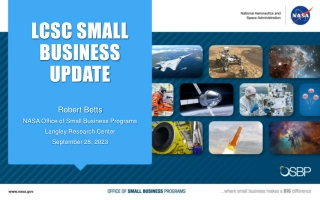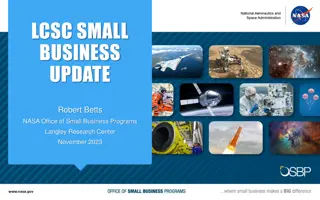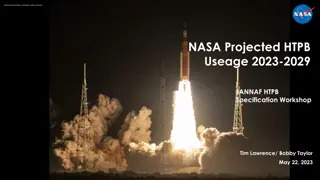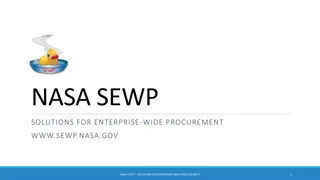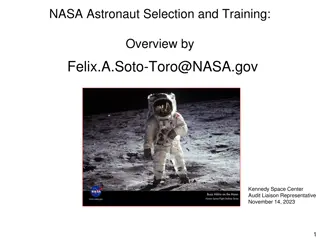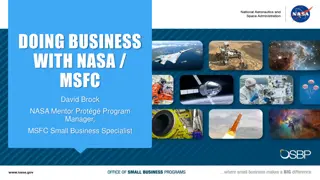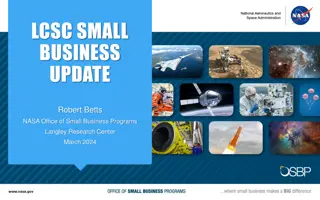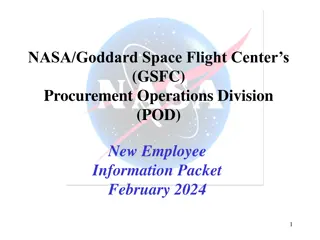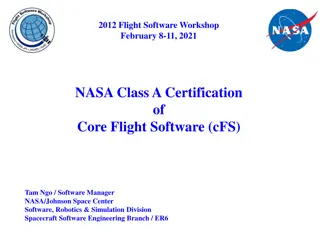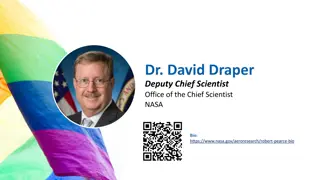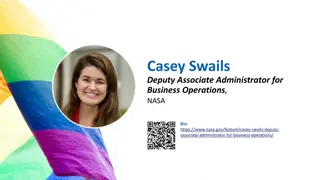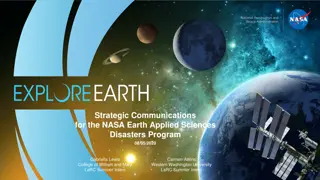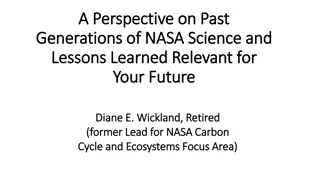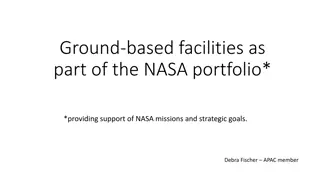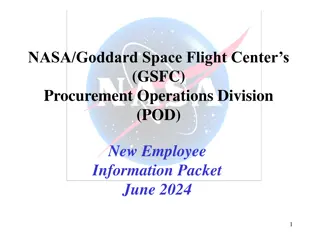Understanding NASA's Class D Projects and Guidance
NASA's Class D projects are characterized by lower scientific priority but higher potential for scientific return at low cost, shorter development timelines, and fewer launch constraints. The agency has issued several guidance documents and implementation plans to streamline these projects and manage risks effectively. The current focus is on reducing management overhead costs and fostering innovation in Earth Science Division initiatives.
Download Presentation

Please find below an Image/Link to download the presentation.
The content on the website is provided AS IS for your information and personal use only. It may not be sold, licensed, or shared on other websites without obtaining consent from the author. Download presentation by click this link. If you encounter any issues during the download, it is possible that the publisher has removed the file from their server.
E N D
Presentation Transcript
Orbital: Class D Discussion Michael Kaszyca ESSP Mission Manager 2023 ESSP Program Forum 1 Earth Science Division
Session Overview This session provides for a discussion and guidance around Class D implementation for Earth Venture projects. If the new Tailoring Policy from SMD has been released, this will also be discussed. 2 Earth Science Division
What is Class D? Per NPR 8705.4, Risk Classification for NASA Payloads o Priority1: Low o Primary Mission Lifetime: Brief, < 1 Year o Complexity and Challenges2: Medium to Low o Life-Cycle Cost: Medium to Low 1Relevance to Agency Strategic Plan, National Significance, Significance to the Agency and Strategic Partners 2Interfaces, International Partnerships, Uniqueness of Instruments, Mission Profile, Technologies, Ability to Reservice, Sensitivity to Process Variations Additional Science Mission Directorate (SMD) Class D Tenets o High scientific payoff but rank lower in science priority (according to references such as the Decadal Survey). o Higher programmatic and technical risks when the potential for high scientific return at low cost has a fair likelihood; however, safety, including not harming host platforms and facilities, may not be compromised. o Shorter development timeline. o Few launch constraints. o If the success of a particular project is absolutely necessary to the success of the portfolio, the project should not be Class D no matter how low its cost. 3 Earth Science Division
Historical Guidance and Documents Several Guiding Documents and Implementation Plans Issued Since 2014 o Guidance and Expectations for Small Category 3, Risk Classification D (Cat3/Class D) Space Flight Projects with Life-Cycle Cost under $150M* signed by NASA Associate Administrator (AA) in September 2014. o NASA Science Mission Directorate (SMD) Class-D Tailoring/Streamlining Decision Memorandum signed by the SMD AA in December 2017. o Request for Deviation from the Federal Acquisition Regulations (FAR) and the NASA FAR Supplement (NFS) 1834.021 Earned Value Management System Policy for SMD Class-D Tailored/Streamlined Missions $150M or less signed by the NASA Assistant Administrator for Procurement in June 2018. o Science Mission Directorate Policy Document (SPD)-39, SMD Standard Mission Assurance Requirements for Payload Classification D, released in April 2021. o NASA Science Mission Directorate (SMD) Class D Tailoring/Streamlining Implementation Plan , released in July 2021. CURRENT SMD GUIDANCE o NASA Office of Chief Engineer (OCE)-57, Guidance for Tailoring 7120.5F Requirements for Small Category 3/Class D Projects, updated in September 2021. o Future, consolidated SMD policy document is pending final review and signature. *$150M threshold excludes launch costs. 4 Earth Science Division
Current SMD Class D Guidance Goals o Reduce management overhead costs, encourage innovation, and allow for more risk by increased relaxation of the formal NASA program management, engineering, and mission assurance requirements. o Higher programmatic and technical risk is acceptable and encouraged by SMD as it broadens science output of SMD portfolio beyond a limited number of low-risk missions. o Increase investment in new PIs and experiment with innovative engineering and program management approaches. o Reduce total overall documentation requirements, including number of separate document submittals, contract deliverables, number of reviewers and approvers, and configuration management burden. o Achieve an 80% success rate for Class D projects in Phases A-D (i.e., complete development within cost/schedule MA and able to achieve Level-1 Threshold Science Requirements) and an 80% success rate for projects in Phase E. (i.e., meets Mission Success Criteria). 5 Earth Science Division
Current SMD Class D Guidance Implementation Highlights o Waived Earned Value Management through formal procurement deviation for projects under $150M. o Developed a pre-populated SMD Class D Tailoring Matrix for NPR 7120.5F. Further tailoring allowed. Allows for merging of numerous separate plans into the Project Management Plan. o Developed SPD-39, SMD Standard Mission Assurance Requirements for Payload Classification D. Key themes include: Emphasis on implementing developer practices that have been proven successful; Using teamwork between NASA and the developer to assure mission success; and Driving efforts based on characterization and management of risk rather than enforcement of broad but prescriptive requirements. o Two (2) HQ-level Key Decision Points (KDPs); KDP-C and KDP-D or E. **SMD AA reserves authority to add KDPs.** Standing Review Boards (SRBs) should be limited to 6 members, plus Review Manager and SRB Chair. Decision Authority delegated to Division Director (ESD) for KDP-D or E. KDP-C decision for an Agency Baseline Commitment (ABC) can be made based on a confidence below the typical 70% level, which is explicitly accepting programmatic risk commensurate with Class D. 6 Earth Science Division
Discussion Common Feedback o Although the principles sound encouraging, trying to implement these has been met with opposition within the Agency and internally within implementing Centers. o Expectations of reduced cost at higher risk overshadowed by unwillingness to accept failure of meeting performance and life requirements with margin, less documentation, streamlined reviews, and less SMA involvement. o Industry and NASA Centers want to avoid the stigma of failures and care more about exceeding life and performance requirements than accepting risk; accepting more risk runs counter to unwillingness to accept failure. Discussion Topics o What does Class D mean to you? Good? Bad? Ugly? o What is acceptable risk/risk management? o Principles/Plans vs implementation (e.g., KDPs required vs proposed; allowable tailoring; contract approaches). o How do we improve? What can we do better? What should we stop doing? 7 Earth Science Division
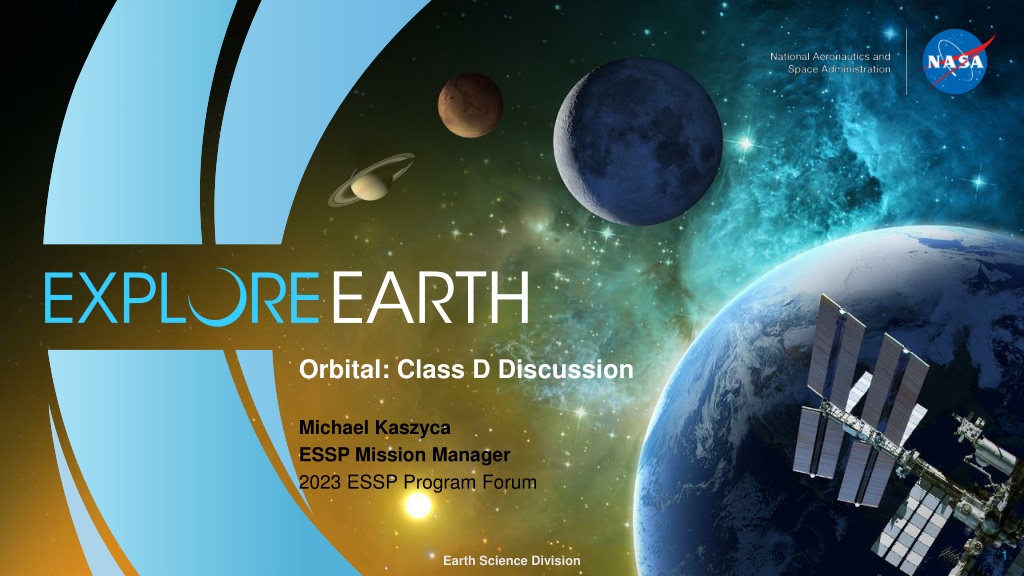

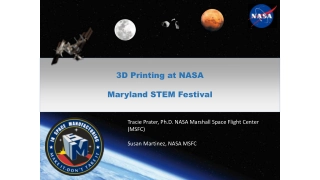
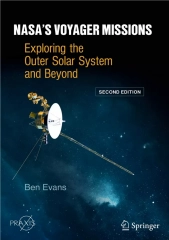
![❤Book⚡[PDF]✔ Doing the Impossible: George E. Mueller and the Management of NASA’](/thumb/21684/book-pdf-doing-the-impossible-george-e-mueller-and-the-management-of-nasa.jpg)
